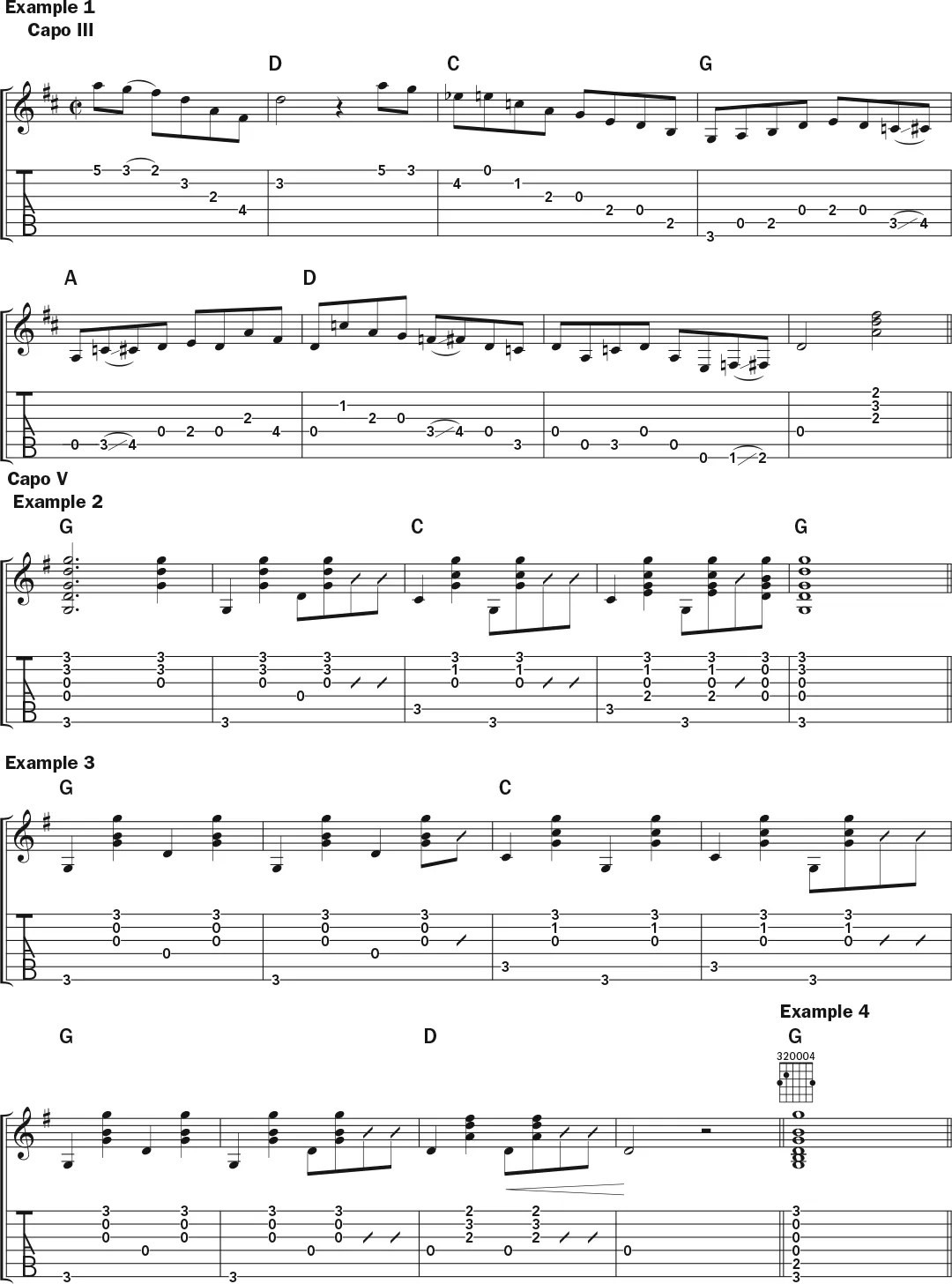Tony Rice remains an iconic figure for countless guitar players, myself included. His passing in December 2020 prompted a deep dive back into his vast discography, reflecting on the profound influence he had on generations of musicians with his truly Distinctive Guitar style. I wanted to share some key aspects of his playing, drawn from songs I’ve studied over the years, that highlight what made his style so unique and impactful.
One track that immediately comes to mind is “Old Train.” Right from the outset, Tony establishes his presence with a guitar solo (Example 1) that bookends the song. This isn’t just a simple rendition of the vocal melody; it’s a statement in itself. The solo intricately traces the chord progression, almost functioning as a separate, instrumental verse. For anyone familiar with Tony’s work, just a few notes from this intro are instantly recognizable as “Old Train”—that’s the hallmark of a truly distinctive guitar voice.
Beyond his groundbreaking lead playing, Tony was a master of rhythm guitar. Musicians who had the privilege of playing with him consistently emphasize his unparalleled ability to lock in with other musicians, creating a powerful and cohesive ensemble sound. In his duet with Ricky Skaggs, “Bury Me Beneath the Weeping Willow,” Tony’s rhythm guitar work is beautifully exposed. In this sparse arrangement of guitar, voice, and mandolin, you can clearly hear his masterful use of space. He plays with remarkable restraint, weaving fills around the vocal phrases while providing ample room for the mandolin to breathe.
 Molly Tuttle Teaches Tony Rice’s Distinctive Guitar Style guitar lesson music notation sheet 1
Molly Tuttle Teaches Tony Rice’s Distinctive Guitar Style guitar lesson music notation sheet 1
As the mandolin enters in “Bury Me Beneath the Weeping Willow,” Tony transitions into a strumming pattern, a bluegrass staple, incorporating the classic boom-chuck rhythm (Example 2). His emphasis on the bass notes is crucial here, carving out space for the mandolin’s percussive chop on beats two and four. He also deviates from the boom-chuck pattern, introducing more dynamic and punchy strums (Example 3) to fill the gaps between vocal lines, showcasing the versatility within his distinctive guitar rhythm.
Bluegrass guitarists often discuss the four-finger G chord, which includes a third-fret D note, instead of utilizing the open B string. However, a close listen to Tony on “Bury Me Beneath the Weeping Willow,” especially during the song’s outro where he articulates each note, reveals his frequent use of a three-finger G chord (Example 4). This is often considered unconventional in bluegrass circles. However, Tony’s embrace of the three-finger G chord, allowing the third [B] of the G chord to ring, adds a unique color to his sound. It’s a testament to his innovative approach—bluegrass guitar doesn’t always necessitate the four-finger G chord.
Another defining characteristic of Tony’s distinctive guitar style, evident in “Bury Me Beneath the Weeping Willow,” is his use of bass runs to connect chords (Example 5). Frequently, at the conclusion of mandolin solos, he employs a signature G run (Example 6), followed by a deliberate pause. This technique of creating space and allowing the music to breathe between sections is another hallmark of his nuanced playing.
“Bury Me Beneath the Weeping Willow” is a song that rewards repeated listening, with new details constantly emerging. My recent discovery of Tony’s frequent use of the three-finger G chord is just one example. Moreover, many of Tony’s rhythm techniques are surprisingly accessible to players at all levels. Beginners can start by learning these strumming patterns and bass runs, making them perfect for bluegrass jam sessions. The true genius of Tony’s distinctive guitar playing lies in its depth and accessibility—there are lessons to be learned for everyone, regardless of playing experience. Even as a long-time guitarist, I continually return to his recordings, finding endless inspiration simply listening to him strum.
For me, Tony Rice’s “Church Street Blues” is the ultimate desert island track. I’m particularly drawn to recordings featuring just Tony and his guitar, where the intricate details of his playing and singing are laid bare. The solo version of “Church Street Blues” available on YouTube offers a fascinating glimpse into his technique, showcasing his crosspicking and his remarkable ability to execute consecutive downstrokes with incredible fluidity. Observing Tony’s right-hand technique is mesmerizing; his thumb moves extensively, engaging his fingers in the picking process, while his left hand remains remarkably economical in its movements. His incorporation of crosspicking into his rhythm playing on “Church Street Blues” (Example 7) is equally captivating. It creates a rich and dynamic accompaniment to his vocals, serving as the foundational thread that weaves the entire arrangement together. Tony Rice’s distinctive guitar style is a gift that continues to inspire and educate guitarists across genres and generations.
